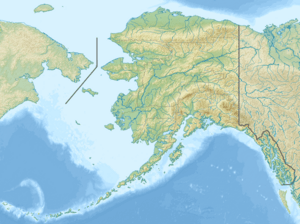Tinayguk River facts for kids
Quick facts for kids Tinayguk River |
|
|---|---|
|
Location of the mouth of the Tinayguk River in Alaska
|
|
| Country | United States |
| State | Alaska |
| Census Area | Yukon–Koyukuk |
| Physical characteristics | |
| Main source | Brooks Range Endicott Mountains 4,619 ft (1,408 m) 67°57′04″N 151°00′34″W / 67.95111°N 151.00944°W |
| River mouth | North Fork Koyukuk River 27 miles (43 km) northwest of Wiseman 1,161 ft (354 m) 67°34′08″N 151°02′30″W / 67.56889°N 151.04167°W |
| Length | 44 mi (71 km) |
| Type: | Wild |
| Designated: | December 2, 1980 |
The Tinayguk River is a beautiful river in Alaska, a state in the United States. It flows for about 44 miles (71 kilometers) and is a branch of the North Fork Koyukuk River. This river starts high up in the Endicott Mountains, which are part of the Brooks Range. It then travels west and south before joining the larger river.
Contents
About the Tinayguk River
The Tinayguk River is a special waterway located in the wild lands of Alaska. It stretches for about 44 miles (71 kilometers) and flows into the North Fork Koyukuk River. The river begins its journey in the Endicott Mountains, which are part of the big Brooks Range. It eventually meets the larger river about 80 miles (129 kilometers) north of a town called Bettles.
Why is it a "Wild" River?
In 1980, the entire Tinayguk River was given a special title: "wild." It was added to the National Wild and Scenic Rivers System. This means the river is very clean and flows freely, without dams or other blockages. It is also mostly untouched by people, meaning it's hard to reach except by walking trails. Its surrounding area is still very natural and wild.
What's in a Name?
The name Tinayguk comes from the Inupiat language. It means Moose. In 1930, a forester named Robert "Bob" Marshall suggested this name. He thought it was a much better choice than "West Fork," which was a common name for many rivers.
Boating on the River
Even though the Tinayguk River is beautiful, it's quite challenging for boating. It is remote and can be hard to get to. Some experienced adventurers use small rafts or inflatable canoes and kayaks to travel on it.
River Challenges
The Tinayguk is a small river with only one main channel. It drops about 80 feet per mile (15 meters per kilometer) in its first 12 miles (19 kilometers). After that, it still drops about 25 feet per mile (5 meters per kilometer). This makes the water move very fast!
Difficulty Levels
The upper parts of the river are rated as Class III (difficult) on the International Scale of River Difficulty. This means there are strong currents and waves. The rest of the river changes between Class II (medium) and Class III.
Things to Watch Out For
Boaters need to be careful of several things. These include the fast current, shallow water, sharp turns, and places where logs have piled up. There are also large rocks and something called aufeis, which is ice that forms on top of the river.


